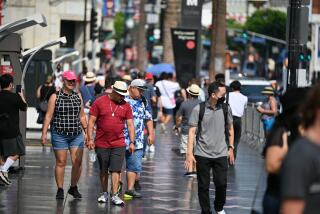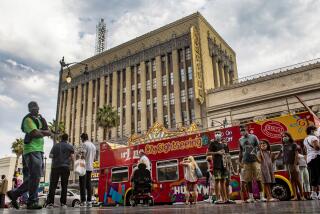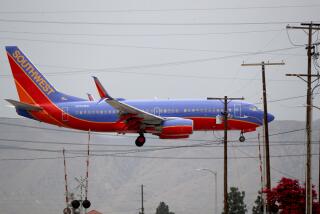Business trips could boost companies’ profits, groups say
- Share via
Jump on a jet for that next business meeting and you may be doing more than pocketing free peanuts. You may be helping the American economy.
That is the message from two studies released this week that claim a direct tie between spending on business travel and increased company profits. The conclusions shouldn’t come as a surprise, considering the studies were released by two organizations dedicated to promoting travel, the U.S. Travel Assn. and the National Business Travel Assn.
But as the country struggles to climb out of the worst recession in decades, the two reports suggest that increased spending on business travel can help put the U.S. economy back on track.
Business travel budgets have been slashed as corporations try to ride out the recession. Spending on business travel in the U.S. is expected to reach $234 billion in 2009, down 10.3% from 2008, according to the National Business Travel Assn., a group that represents 15,000 business travel professionals.
But both studies say a boost in business travel spending can act as the energy drink our slumping economy needs to start flying again. The assumption is that face-to-face meetings generate more clients, better business deals, greater revenue and healthier profits.
The study commissioned by the U.S. Travel Assn., a trade group representing about 2,000 travel organizations, said a 10% increase in spending on business travel would boost the country’s gross domestic product by 1%. Such an increase would be enough to shove the economy out of its recession, said Adam Sacks, a managing director at Oxford Economics, the research firm that produced the report.
The U.S. Travel Assn. study, based on surveys and “econometric analysis” from the last 13 years, concluded that for every dollar invested in business travel, companies can generate an average of $12.50 in revenue and $3.80 in profit.
The study was read by Martin A. Asher, an adjunct professor of finance at the Wharton School, who declared the analysis sound.
The National Business Travel Assn.’s study concluded that businesses can make an incremental increase of $15 in revenue for ever dollar spent on business travel. If businesses increase travel spending to “optimum levels,” the boost would create 5.1 million new jobs and generate more than $101 billion in tax revenue, according to the study, conducted by IHS Global Insight, an economics research consulting firm.
“Decisions to cut travel are very shortsighted,” Sacks said.
Forecast worsens for airline losses
The drop in business travel has had a direct effect on the airline industry.
The International Air Transport Assn. revised its global financial forecast this week, predicting global airline losses totaling $11 billion in 2009.
That is $2 billion worse than the previously projected $9-billion loss. The revised figure is partly due to rising fuel prices and a continued decline in demand.
The association predicted that demand would drop 4% compared with last year, and Giovanni Bisignani, the group’s director and chief executive, said he could foresee no industry rebound until 2012 at the earliest.
“We are in intensive care and the crisis for us is not over,” he said.
Flu shots at LAX are in the works
With the growing fear over the H1N1 influenza virus, the idea of offering flu shots at airports has taken off.
Several major airports, including Boston’s Logan, Chicago’s O’Hare and New York’s John F. Kennedy, have offered flu shots, either in the terminals or at nearby clinics. The price ranges from $20 to $35.
In years past, passengers at Los Angeles International Airport could ride a courtesy van to the nearby Reliant Immediate Care Medical Group for $25 flu shots.
But this year, Dr. Max Lebow, medical director for Reliant, said he was meeting with airport officials to launch at least one flu shot kiosk in a terminal. He hopes to work out the details in the next week or so.
The shots for traditional influenza should be available at the end of the month, with shots for H1N1 expected in October, Lebow said. Details will be available at the first aid station at the Tom Bradley International Terminal, he said.
“A lot depends on the demand,” Lebow said. “We expect to have a high demand this year.”
--
More to Read
Sign up for The Wild
We’ll help you find the best places to hike, bike and run, as well as the perfect silent spots for meditation and yoga.
You may occasionally receive promotional content from the Los Angeles Times.







